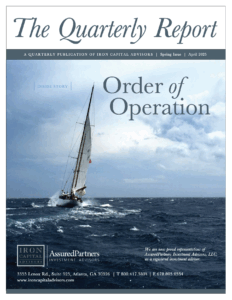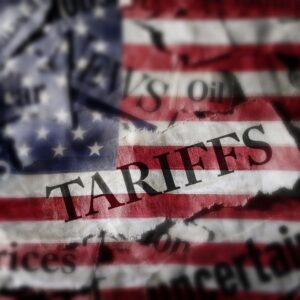I was 20 miles offshore, sailing north from St. Simons Island, Ga., headed to Charleston, S.C. The forecast was for strong winds so I had already reduced sail before the sun went down, but the forecasted wind had not showed up. I was beginning to question my decision to be so conservative when, at 12:30 a.m. off the coast of Savannah, Ga., the wind came. It seemed as if someone upstairs suddenly remembered they were supposed to turn the wind on, and they flipped the switch. In an instant we went from a light breeze to more than 30 knots of wind, and I quickly realized that I had not reduced sail enough.
The process a sailor goes through to reduce sail is called reefing. Every boat is rigged a little bit differently but the one thing they have in common is that there is a detailed step-by- step process for putting a reef in the sail, which makes the sail smaller and helps control the boat. On this boat the first step is to turn into the wind to reduce the pressure on the sail, then ease off of the various control lines to allow the sail to be lowered to the appropriate point. Once reefed, the control lines must be re-tightened, and then the boat can be turned back on course. Do those steps in order in a controlled manner and within a few short minutes you will have the boat back in control with more comfort and safety; but do any one of those steps out of order and total chaos will ensue. The order of operations matters.
Donald Trump has come back into office with an economic plan that is a three-legged stool. As always, we don’t discuss politics, but we do discuss economic policies that can impact your portfolio, so let’s take a look. One leg of his plan is regulatory reform, trying to make is easier to start and run a business in the U.S. The second leg is tax reform, really making his previous reforms permanent with perhaps a few other areas of tax relief. The third and final leg is his desire to have high tariffs to make it difficult for Americans to buy goods from international companies, which he believes will stimulate more domestic production.
Let’s break those down. The regulatory reform is the one that gets me excited. This is often a tough issue because it is nuanced, and we don’t do nuance well in our modern society. The opponents of deregulation build straw man arguments about there being no rules. No one wants to live in a society with no rules, but there is something called too many rules. One problem we have in America is that we are continually making new rules and seldom (if ever) getting rid of old rules. The labyrinth of red tape makes it very difficult for people to start new businesses.
Over-regulation also leads to what economists call rent seeking. Wealthy corporations can lobby the government to enact rules that benefit them and make it harder for small companies to compete. As Milton Friedman noted in his 1962 classic, “Capitalism and Freedom,” there is a direct correlation between the amount of regulation is a society and the amount of inequality. In my opinion, the economic community unfortunately has not done enough work on regulation, because it is difficult to quantify the impact of rules.
In The Bible, God gave Moses 10 rules. The United States Code of Federal Regulations (CFR) contains more than 186,000 pages of rules. Maybe 10 is too few for our modern world, but certainly there is a number between 10 and 186,000 that would make for a clearer, fairer system.

Tax reform, especially corporate tax reform, was desperately needed when Trump was first elected in 2016. The United States had the highest corporate tax rate in the developed world, which made it hard for smaller companies in particular to compete with large corporations that could lobby for loopholes. That is historically the biggest issue with high tax rates: The rich, who are supposedly the target of high rates, use their connections to get loopholes…so it is the small companies that end up being hit by the high corporate tax, which reduces growth and makes it harder for them to compete. Corporate taxes also are a tax on employees. There have been many studies to show that companies simply reduce wages to pay for corporate taxes; when the tax is reduced, wages rise. This occurred during the first Trump administration when, for the first time since the 1980s and 1990s, the bulk of economic growth actually went to the middle class.
On the personal income tax side, the need for reform was much less when Trump took office in 2016 and his cuts were far less effective. His new ideas of no tax on tips and no tax on social security will certainly benefit specific people, but that is not the best way to structure a tax system. The ideal would be to have a fair system where everyone would “pay their fair share,” no more and no less. That means having a low overall rate with few, if any, loopholes.
This brings us to the third leg: Tariffs. I struggle to understand why Trump believes this is a good idea. It is inconsistent with his other two priorities, which are clearly designed to reduce government’s impact in our daily lives. Tariffs are big government at its worst, protecting favored industries while hurting the masses with higher costs and/or little to no access to desired products or services. We have written about and discussed this subject quite a bit and will continue to do so as necessary. Bottom line for our purpose here is that tariffs are a tax on U.S. consumers and will slow economic growth.
In his first administration, Trump led with tax reform. House Speaker Paul Ryan had already designed a Republican blueprint for tax reform, so it was relatively easy to get passed. This stimulated the economy. Many of America’s largest multi-national corporations had been keeping cash overseas because of the existing corporate tax system, and that influx of capital in particular jump-started great growth.
Next came the regulatory reform. In true Trump fashion he made a theatrical presentation of cutting the red tape. More substantively, the administration came up with a brilliant plan: For every new regulation, the government identified two older regulations that had to be removed. This kind of strategy makes enormous sense. Rules become outdated; we all intuitively understand this. We see examples of local ordinances still on the books regarding where one is allowed to tie up his horses downtown; there are plenty of old rules which could probably go away. I also have firsthand business experience dealing with rules that contradict one another. Modernizing while also streamlining the United States regulatory framework is the best way to cut down on those 186,000 pages while maintaining the rules we still need.
Combined these two initiatives brought us what most remember as “the Trump economy.” Growth went up dramatically, the stock market soared, and all was good in the world. GDP growth went from 1.5 percent to 2.9 percent. Then, Trump declared his war on trade. GDP growth in 2019, before Covid, came back down to 2.3 percent. People forget that initial drop, because Covid hit shortly thereafter and drowned out everything. However, it was clear at the time that Trump’s agenda had led to two big steps forward and one leap back.
This brings us to Trump 2.0. He campaigned largely on a return to his three-legged economic plan. However, this time there was far more emphasis on enacting trade barriers. There were also more targeted political promises. The no tax on tips, for example, will certainly help some, but it is not the well-balanced reform plan that would benefit all. He also unleased DOGE, which helped reduce the size of government, but to benefit the economy that needs to be accompanied by actual regulatory reform to reduce the intrusion of government into our daily lives.
The biggest change, however, is in the size of his ambitions and, more importantly, the order in which he has decided to tackle his priorities. This time he has led with tariffs, including an inconsistent message regarding their purpose. Many in his administration have suggested that this is a negotiation tactic to get better trade deals, yet Trump himself seems to suggest that the tariffs are permanent. He launched them all at once and with amounts much higher than anyone expected based on conversations with the administration.
This has caused turmoil in financial markets and a dramatic slowing of economic growth. The Atlanta Fed’s GDPNow measure is showing a negative growth rate in the 2025 first quarter GDP. The model, as of April 3, is indicating a drop of 2.8 percent. This has been exacerbated by imports of gold that are not in the actual GDP formula, so when adjusting for that, the measure shows a drop of 0.8 percent. Considering that Trump inherited an economy which was growing at 2.8 percent in 2024 that is a lot of damage in a short period of time.

Unlike the two steps forward and one step back of his first administration, this time Trump has started with the step backwards. There are many who believe this is on purpose; they point to the Reagan years, which began with a recession but ended with what was at the time the longest economic expansion in U.S. history. The belief is there will be short-term pain but long-term gain.
This could happen, assuming Trump follows through with his other two economic initiatives. Regulatory and tax reform will help stimulate growth and could come to the rescue. There will also be trade deals done, and it would be very surprising if these tariffs are not challenged in court.
The Constitution gives Congress the power to issue tariffs, not the president. While more and more of the authority of Congress has been transitioned to the executive branch, there are limits which Trump is certainly pushing. In fairness, Biden also pushed the limits with his student debt forgiveness, which the courts stopped.
This leads to another matter. Because all of this is being done by executive order, the next person in the White House could just reverse course. The long success of the United States and our system is largely driven by the slow mechanisms of the balance of power and the need to rule by consensus and get things done in Congress. This has kept us from bouncing back and forth from extremes based solely on who won the last presidential election. If Trump wishes to make a lasting change, then he needs to make Congress do its job and pass laws instead of just writing executive orders.
The order of operations and how things are done matters. Two steps forward and one step back feels much different than starting with one step back. Getting things through Congress as our system is designed may take a long time and require some compromise, but that has actually been the secret of our success as a country.
In the meantime, what are we to do as investors? Well, we must focus on what we can control. We have navigated rough spots before. When at sea it is best to try to avoid storms, but sometimes that is not possible. In those times, we just have to reduce sail and go through the storm. There is always a calm on the other end. We will make it through together.
Warm regards,

Chuck Osborne, CFA
The 4rd quarter 2024 GDP growth came in up 2.4 percent, which is still solid but less than expected. GDPNow shows the economy shrinking by 0.8 percent in the 1st quarter due to tariffs. The broken clock doomsayers might finally be right.
The official unemployment rate was 4.2 percent through March. The labor market remains steady. We have been in the 4 percent range for a while now. This will be a key indicator of any potential recession and we will be watching it closely.
Inflation is 2.8 percent based on the latest consumer price index report. There has been progress since the last quarter’s reading. The producer price index, which tracks wholesale prices, is up 3.2 percent over the last 12 months, slightly below last quarter but above retail levels. +
The market dropped in the 1st quarter. For the quarter the S&P 500 finished down 4.21 percent, while small company stocks represented by the Russell 2000 index were down 9.48 percent. Value held up better with the Russell 1000 Growth index down 9.97 percent while the value index was actually up 2.14 percent. For small companies the value index was down 7.74 percent, and the growth index was down 11.12 percent.
Bonds were up as interest rates dropped. The Bloomberg U.S. Aggregate Bond index ended up 2.78 percent. High yield bonds rose 0.97 percent. Bond yields went from the highs of their range to the lows of their range. They have behaved as bonds should during a down market, providing much needed relief.
International stocks were positive. The EAFE index finished up7.01 percent and the MSCI Emerging Markets index ended the quarter up 3.01 percent. +
Seldom does a single act change everything, but this is one of those times. With tariffs going into place the outlook in the short-term is negative. Defense will be the key for the foreseeable future. However, stay alert because what was done by a single action could also be undone by a single action.
Ultimately stocks will be driven by fundamentals regardless of government policy. Valuations have come down quickly. International will likely continue to do relatively well as a weak dollar will assist U.S. investors in foreign markets. Small companies will likely struggle more than large companies to find tariff work arounds. A flight to quality will likely take place.
Bonds have done their job in protecting on the downside. There will continue to be downward pressure on rates as growth slows due to trade restrictions. +